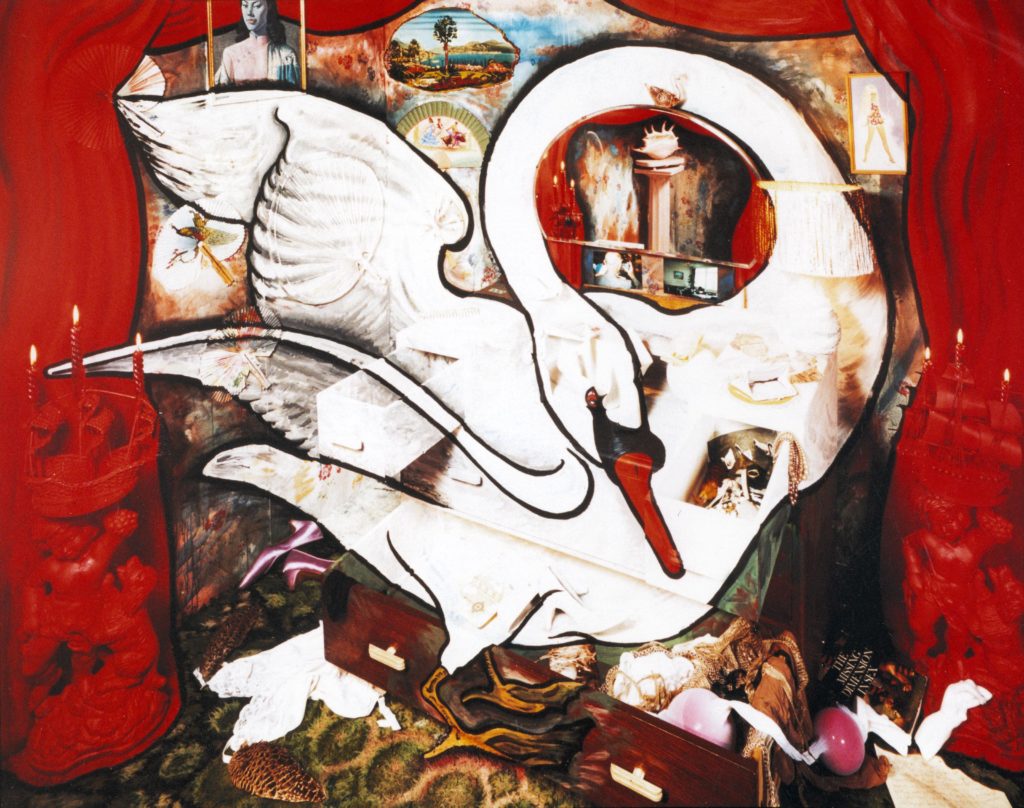
To mark the 25th anniversary of the founding of the Harry and Margery Boswell Collection at the University of St Andrews, Clare Fisher interviews artist Calum Colvin
According to The Courier (July 2017), Mute Swan is your personal favourite from the ornithology series. Why is this?
I think this was because I enjoyed making it so much! I had been working for a few years in a kind of digital photomontage style which involved a lot of pre-planning and multiple shots (this was the two exhibitions The Seven Deadly Sins and the Four last Things 1993, and Pseudologica Fantastica 1996) and the opportunity to return to a relatively simple set-up, involving a large-format camera, a few props and some tins of paint in order to make a work in ‘one-shot’ was refreshing and exciting! There was a kind of looseness of approach and spontaneity which really energised me.
How do you see this work responding to the depictions and symbolism of swans in art history? You mentioned that Michelangelo’s Leda was a distant reference point once.
When creating this work I was interested in the way that symbolism associated with the swan seemed to have multiple associations across various cultures. In some regions it was considered a feminine symbol associated with the moon. Its presence was a sign of intuition and gracefulness, considered feminine attributes. The goddesses Aphrodite and Artemis were sometimes accompanied by swans. More often, the swan was a masculine symbol. Its pure white colour connected it to the sun, almost always a masculine deity. The swan was linked in ancient Greece to Apollo, god of the Sun. The work exploits this duality by incorporating masculine and feminine references within the artwork whilst making a more distant reference to Michelangelo’s ‘Leda’ in terms of structure, colour, shape and of course referencing the story, also from Greek mythology.
Can you tell us how you made the Mute Swan, what was the process involved? How did you decide what objects or props to include?
Deceptively simple! The work is essentially a three-dimensional stage set on the back wall of my studio, created specifically to be read from the fixed-point perspective of the camera. A drawing on the back of the camera is mapped on to this set and gradually painted over the disparate surfaces until a fully formed trompe l’oeil hybrid painting/photograph is created. The props are on the one hand a kind of armature for the three-dimensional qualities and on the other a symbolic commentary on the subject of the image. Other objects suggest layers of narrative, often quite ambivelant. Finally the ‘set’ is lit and photographed onto 10”x8” transparency film, scanned and printed.
How do you see this work approaching questions of gender?
I was certainly thinking about gender differences, or even tensions in the work, also male and female desire. I also thought of the swan as portraying both masculine and feminine qualities.
How did you come across John James Audubon? What was it about his work that you were drawn to?
I think Audubon is one of those artists you just seem to know. His work is so ubiquitous! I think I was drawn to a taxonomical approach, or more precisely a kind of satire of this approach with a series of allegories which had an ornithological framework for a range of works with a social/ecological context. Audubon was an obvious reference point in this regard, I suppose.
In his Birds of America prints, Audubon chose to depict each bird at its actual size. How important are questions of scale in your constructed worlds?
Scale is very important. Technically, I make works with a 10”x8” camera onto transparency film which allows a tremendous scope for detailed and richly colour saturated images. This of course lends itself to the possibility enormous scale prints, which I have often opted for. Equally, a smaller scale allows a more intimate connection with the viewer. The venue and context in which the work is displayed often dictates the scale, which of course in photography you have the luxury of varying within your edition of works.
How big a part does the viewers reaction to your art play in the making of it?
For me, this is part of the internal dialogue. How the viewer might ‘read’ the work. You find yourself trying to look anew, detached, to see the works as others might. Of course this is a little futile as there is a kind of silent engagement between the work and the viewer that can’t be fully known or controlled by anyone. This is what draws me to this particular process of image-making, which is both simple and complex, as well as being deeply ambiguous by it’s very nature.
Clare Fisher is a PhD student in the School of Art History funded by the Scottish Graduate School for the Arts and Humanities. Her research explores the discourse of monumentality in the United States from the Civil War to the present day.